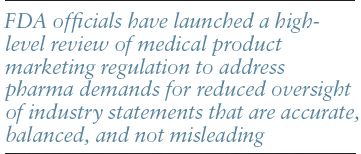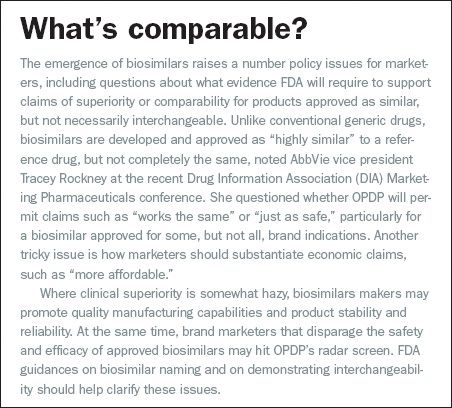Are Times A’Changing for Drug Marketing?
Pharmaceutical Executive
FDA is under pressure to moderate oversight of pharma advertising and promotion.
Less restrictive rules on drug advertising and promotion may be emerging from FDA, as the agency responds to high court decisions questioning government actions that curb communications, particularly truthful statements. Radical shifts in the prescription drug market, moreover, are directing industry promotional efforts away from prescribers and toward informed payers that decide coverage based on broader outcomes data, as opposed to company advertising.
Jill Wechsler

FDA officials have launched a high-level review of medical product marketing regulation to address pharma demands for reduced oversight of industry statements that are accurate, balanced, and not misleading -including discussions of off-label uses. The hope is that this will lead to greater flexibility in how companies convey risk information through new media and to new audiences.
Getting briefer
A sign of the times is FDA's recent publication of guidance on how to provide a "brief summary" of drug side effects and effectiveness in print ads to be more helpful to consumers. Although everyone has long quipped that the tiny-print package insert accompanying drug ads in newspapers and magazines is neither "brief" nor a "summary," it has taken the agency more than a decade to modify this requirement. The process has involved research studies on whether consumers actually read brief summaries (less than half), if detailed safety information is useful (not very), and which formats best convey important risk information (fairly simple ones).
The revised guidance actually discourages distribution of full prescribing information to consumers and "strongly recommends" that marketers adopt more patient-friendly formats and present a clearer and more useful summary of most pertinent information on the advertised product. The February guidance (http://www.fda.gov/downloads/Drugs/GuidanceComplianceRegulatory Information/Guidances/UCM069984.pdf) was developed by the Office of Prescription Drug Promotion (OPDP) in the Center for Drug Evaluation and Research (CDER) and replaces one from 2004. It directs advertisers to use headings, larger fonts, and more white space to make prescribing information easier to read and recommends highlighting significant information such as boxed warnings, frequent adverse events, and key indications. There's even specifics on adopting clear language, such as "do not use" instead of "contraindication."

Newspapers and magazines may lose business because pharma companies will be able to run shorter ads, but medical journals still should see lengthy promotional pieces, as the abbreviated format is limited to consumer-directed communications; health professionals will continue to see the full PI.
This quest for clear, more useful drug information could carry over to direct-to-consumer broadcast advertising in the future. OPDP issued a notice a year ago seeking comments on options for modifying the lengthy risk information provided in TV drug commercials. The aim, similarly, is to make consumers more aware of most important safety issues for a medicine, and not muddy the picture with long lists of possible side effects. OPDP is testing various formats for "major statements" in DTC drug ads, though any policy change is years away.
Marketers asked OPDP staffers at the Drug Information Association (DIA) Marketing Pharmaceuticals conference in February whether to start revising brief summaries as proposed in the new guidance-or wait 10 years for a final version. It's still unclear just what items advertisers can omit from a brief summary, largely because consults with OPDP reviewers on voluntary modifications in risk information often have yielded requests to add more specifics to these statements. But OPDP regulatory counsel Julie Chronis advised industry to start implementation now, even though some of the details may change. Comments are due May 10.
Social media struggles
Last year OPDP also issued highly anticipated guidances on the appropriate use of Internet websites to convey information on prescription drugs. One advisory addresses communicating about drugs in limited spaces, such as 140-character "tweets" with little room for risk information. Another discusses how companies may correct erroneous information about a drug posted by third parties. OPDP also advised companies not to submit every new Internet posting for agency review, but to provide periodic updates on online communications activity. Further guidance is expected on how marketers can convey risk information through "links" to additional sites, a common Internet practice but one that FDA has found inadequate for ensuring fair balance about drug communications.
While FDA says it aims for more clarity and flexibility, marketers complain that the new policies are impractical, confusing and overly restrictive. If a pharma company wants to correct a third-party message, for example, that may mean correcting all postings on a topic-or face "cherry picking" charges from OPDP. Some companies thus are deciding not to correct anything, even though that approach may not be best for public health, commented attorney Scott Liebman at last month's IBC Pharmaceutical Compliance Congress.

What's comparable?
In addition to revising these guidances to further clarify how companies may use social media more effectively, industry is anxious for FDA to lay out a more practical approach for providing economic information on medical products to "educated" parties, such as formulary committees, insurers, and payers. FDA has promised guidance for marketers on conveying healthcare economic information in promotional materials, an important topic that has been mired in dispute for decades.
It's not surprising, though, that pharma companies are nervous about modifying brief summaries and experimenting with Internet postings, as inadequate risk information continues to be the main compliance issue cited in OPDP enforcement letters. There have been fewer OPDP enforcement actions in the last year-only 10 untitled letters in 2014, compared to 26 in 2013-but overstatement of benefits compared to side effects remains the top violation.
OPDP director Tom Abrams suggested at the DIA conference that the decline in enforcement action may arise from FDA success in gaining voluntary correction of noncompliant materials before stronger enforcement action is needed. Despite such gains, industry critics continue to contest moves to liberalize FDA pharma marketing rules. Public Citizen's Sidney Wolfe recently broadcast strong opposition to the agency's proposal to permit marketers to hand out peer-reviewed journal articles to doctors. Wolfe cited thousands of individual comments filed with FDA that similarly reject this revised policy and warned that pharma journal handouts would undermine FDA's authority, mislead customers, and endanger patients. Evidently, not everyone seeks moderation in the pharma promotion area.
Jill Wechsler is Pharmaceutical Executive's Washington correspondent. She can be reached at jwechsler@advanstar.com
Have your say: leave a comment below

Navigating Distrust: Pharma in the Age of Social Media
February 18th 2025Ian Baer, Founder and CEO of Sooth, discusses how the growing distrust in social media will impact industry marketing strategies and the relationships between pharmaceutical companies and the patients they aim to serve. He also explains dark social, how to combat misinformation, closing the trust gap, and more.
FDA Grants Priority Review to Regeneron’s Eylea for Macular Edema Following Retinal Vein Occlusion
April 18th 2025Regulatory action was based on data from the Phase III QUASAR trial, which demonstrated that Eylea HD dosed every eight weeks achieved non-inferior visual acuity outcomes compared to Eylea in patients with macular edema following retinal vein occlusion.
Pfizer, GSK Gain ACIP Recommendations for RSV and Meningococcal Vaccines
April 18th 2025The Centers for Disease Control and Prevention’s Advisory Committee on Immunization Practices voted to expand access to Pfizer’s respiratory syncytial virus vaccine Abrysvo for high-risk adults in their 50s and voted in favor of GSK’s meningococcal vaccine, Penmenvy, for streamlined adolescent protection.